Wisconsin's rural homelessness crisis and the ongoing fight to do 'more with less'
Homelessness in rural Wisconsin, while often unseen, is increasing, yet a grueling funding landscape, among other challenges, poses obstacles for local shelters and rural providers.
Wisconsin Watch
January 9, 2025 • Northern Region
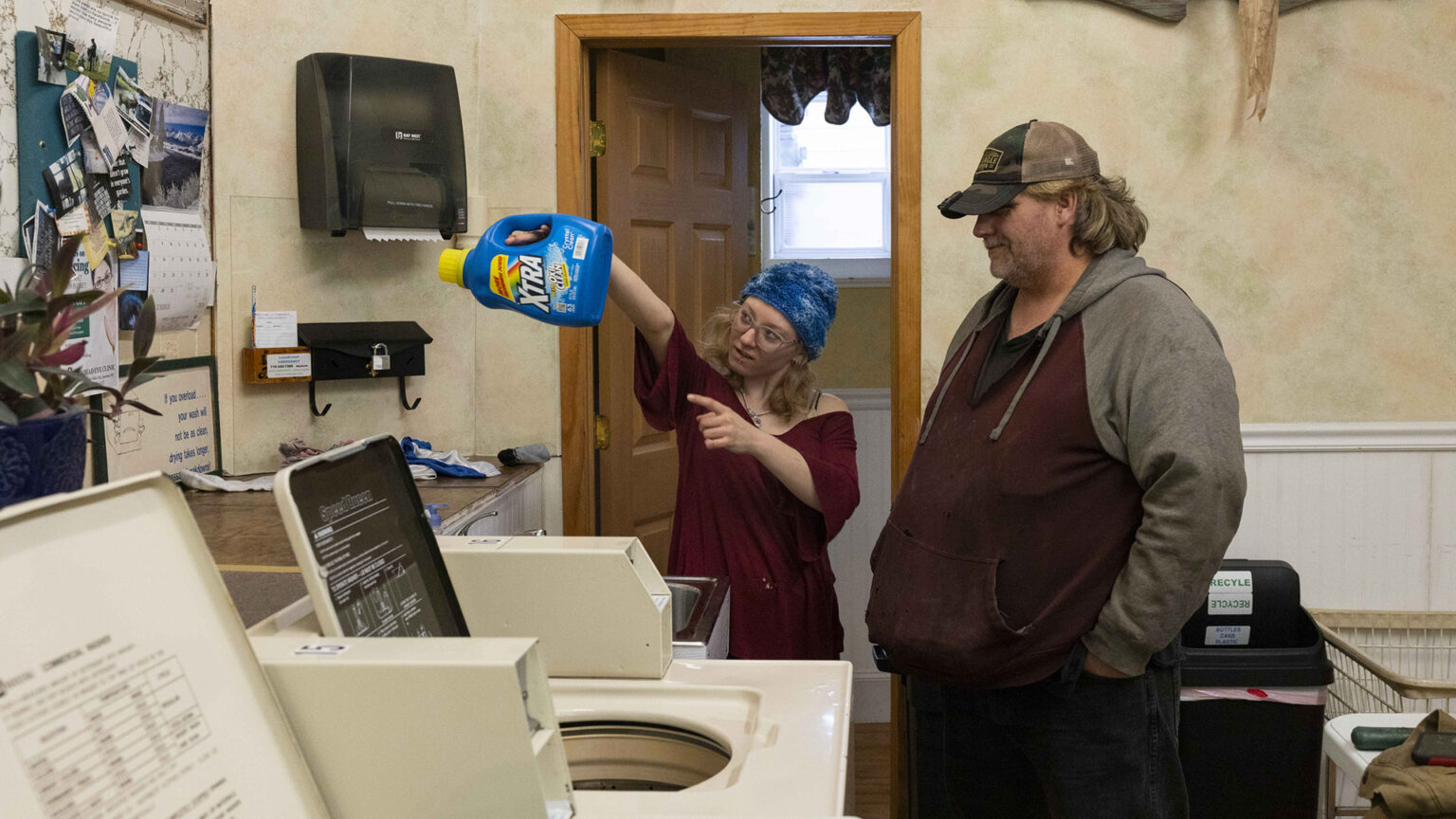
Christina Hubbell, left, shows her father, Eric Zieroth, how she is running hot water at a laundromat to melt their frozen laundry detergent after picking up their winter clothes from a storage unit they share on Dec. 3, 2024, in Shell Lake. Zieroth and Hubbell had recently moved into a friend's basement apartment after living in their car for over a year. Most of their belongings, including their winter clothing, are kept in their storage unit. (Credit: Joe Timmerman / Wisconsin Watch)

This story was produced and originally published by Wisconsin Watch, a nonprofit, nonpartisan newsroom.
Last winter, Eric Zieroth dressed in as many layers as he could and stayed beneath a down blanket each night. He learned it was the best way to keep warm while living in his car in far northwestern Wisconsin.
During those cold months, he and his then-20-year-old daughter Christina Hubbell had to wake, start the vehicle and blast the heat a few times a night before shutting it off again.
For over a year, the pair regularly parked their PT Cruiser — a car older than Hubbell that Zieroth, 47, called “a shoebox on wheels” — in a corner spot at a public boat landing on Long Lake. The lot is less than a mile from the rural city of Shell Lake, with a population of less than 1,400.
Down a dirt road and tucked into the woods, they slept at the secluded launch to stay out of the way in the town where they spent most of their lives. Now, because they are homeless, they have been ostracized for showering, parking and sleeping in public places.
Washburn County has no homeless shelters, and they don’t have family to stay with. Hubbell’s mom and Zieroth divorced in 2022. The following year, when Hubbell was 19, her mom told her to start paying rent or leave.
Hubbell’s job at a Dollar General in Shell Lake — their only source of income — keeps them from relocating to a shelter in another county. They are on a waitlist for a low-income housing unit.
Zieroth is awaiting a surgery that will allow him to get back to work. With no way to heal or keep the wound clean, he said he couldn’t get the operation while living in his car. If it weren’t for his daughter, the former mechanic said he might have considered committing a crime and getting booked into jail instead of spending another winter in the vehicle.
“There’s no way I could do it again,” Zieroth said. “I had to figure out something else this year.”
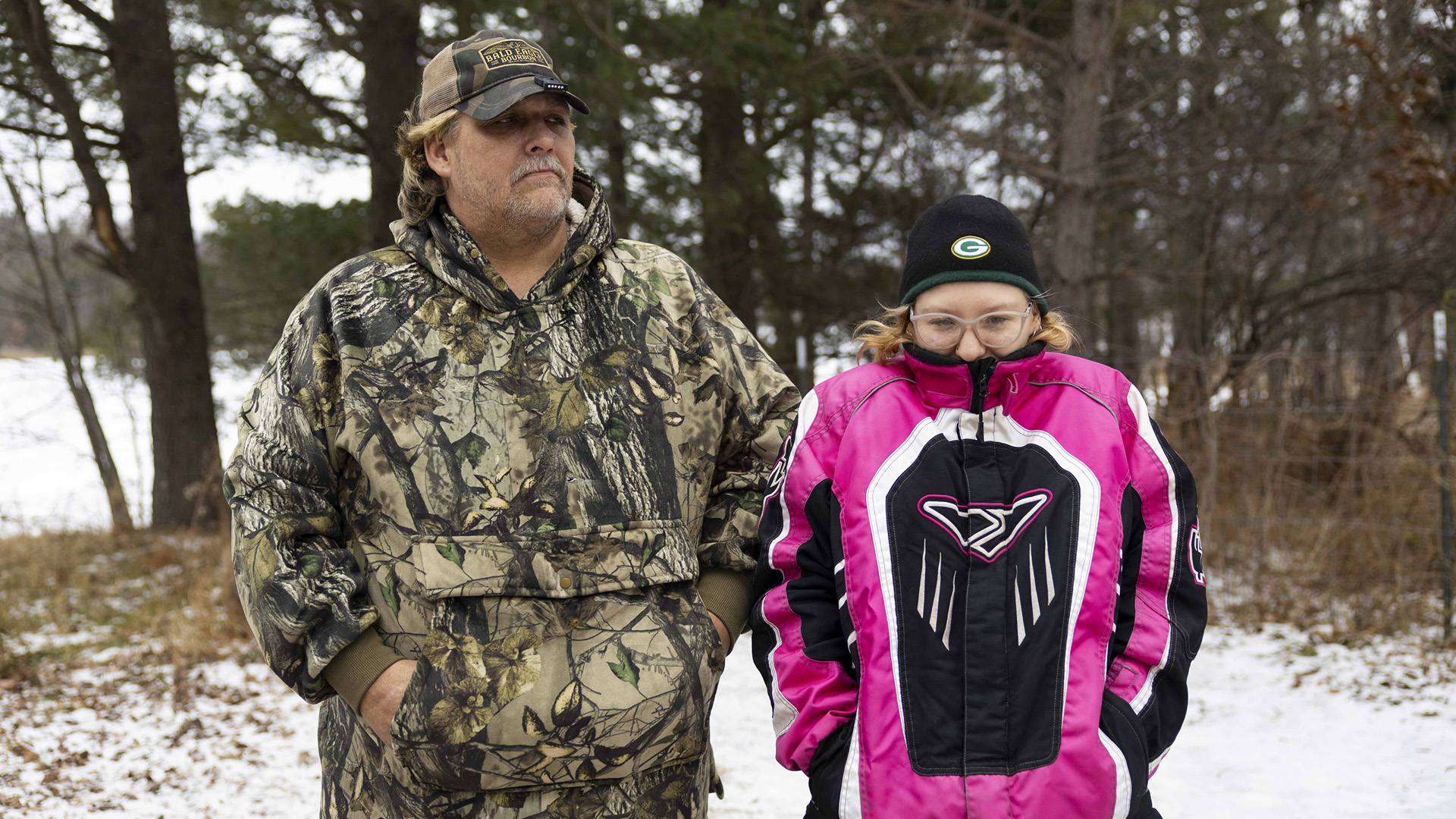
Eric Zieroth, left, and his daughter, Christina Hubbell, right, pose Dec. 4, 2024, in Shell Lake, for a portrait at a public boat landing on Long Lake where they spent many nights sleeping in their car over the last year. (Credit: Joe Timmerman / Wisconsin Watch)
In rural Wisconsin, homelessness is often hidden behind a veil of individuals and families who are couch surfing and sleeping in their vehicles instead of sleeping on city streets or camping out in parks. Resources are few and far between, shelters are always full, and funding can be a significant challenge at the local, state and federal level.
After falling for years, the state’s estimated homeless population has been rising since 2021. It rose again from 4,861 in 2023 to 5,037 in 2024. In the “balance” of the state — all 69 counties outside Milwaukee, Racine and Dane — the homeless population increased from 2,938 individuals in 2023 to 3,201 in 2024, according to data Wisconsin Watch obtained from the region’s continuum of care organization, which conducts homeless counts each year.
Despite accounting for over 60% of the state’s homeless population in 2023, these mostly rural counties collectively contain just 23% of the state’s supportive housing units — long-term housing models with on-site supportive services, which experts say is the best way to address chronic homelessness. But providing long-term housing and services on top of shelter is an expensive, labor-intensive task for small, rural providers with limited funding.
According to the Department of Public Instruction’s latest data, 18,455 students experienced homelessness during the 2022-23 school year — a number that has increased each year since 2020. Some 11,000 of these students reside in districts outside of Milwaukee, Madison, Racine and Green Bay.
The annual data collected on homelessness are an undercount, especially in rural areas, said Mary Frances Kenion, vice president of training and technical assistance at the National Alliance to End Homelessness. That means less funding for already disadvantaged smaller communities.
“Where there’s more concentration of people, that’s always going to drive funding, because we have block grant funding that is directly tied to the census,” Kenion told Wisconsin Watch.
Despite rural communities having fewer nonprofits than urban ones, shelters and housing assistance programs are leading the way to address the expanse of homelessness in rural Wisconsin.
“Funding and access to resources is a challenge … but there are some really bright spots in rural communities, because they are doing more with less,” Kenion said. “We’re seeing a ton of innovation and resilience just by virtue of them being positioned to do more with less.”
But shelter directors and anti-poverty advocates face many hurdles when it comes to funding, resources and support.
Rural shelter providers across the state identified several solutions to the problem: Cutting out county governments as the middleman for state reimbursements, increasing the availability of new rental units, consolidating multiple definitions of homelessness, more consistent and proportional state funding, and assistance with case management are just a few.
Point-in-time counts, federal funding and HUD
The annual “point-in-time” homeless counts are collected by continuum of care organizations across the country on a single night during the last week of January. Wisconsin has four designated organizations with three covering Milwaukee, Dane and Racine counties and one for the other 69 counties.
The counts are submitted to Congress and the U.S. Department of Housing and Urban Development (HUD) for consideration and funding determinations. They are meant to include those living in temporary shelters, as well as unsheltered people living on the street, but do not include people in other sheltered situations. Those living in cars are often missed.
“They’re typically either in their car or they’re on somebody’s couch,” said Jenny Fasula, executive director of Wisconsin’s Foundation for Rural Housing. “People on the couches don’t count in your PIT counts because they’re ‘housed.’ People in cars in rural areas — I don’t even know where you’d find them, except maybe a Walmart parking lot.”
Since 2009, HUD — the main federal agency that handles homelessness — has targeted permanent supportive housing programs with long-term, sustainable services like case management for federal funding. The national shift from temporary housing programs reflects a widely adopted “housing first” approach — that the security of a permanent shelter is the first, necessary step before people can address the root causes of their homelessness.
“Temporary housing programs shifted their gears towards that other type of service so they could continue to operate and get funding to operate,” Wisconsin Policy Forum researcher Donald Cramer told Wisconsin Watch.
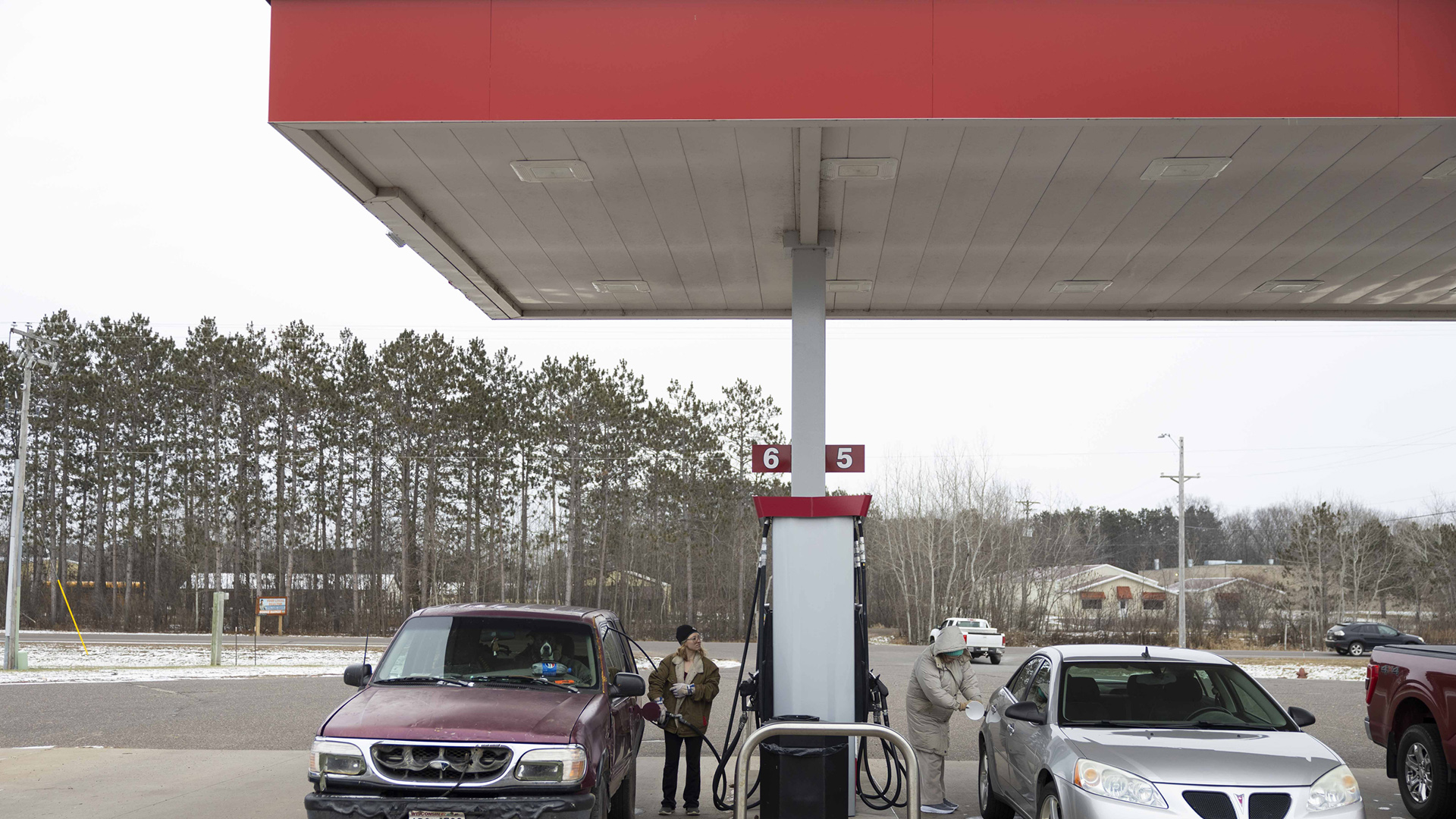
Christina Hubbell fills up the car with gas as her father, Eric Zieroth, and their dog, Bella, wait in the car Dec. 3, 2024, in Shell Lake. Zieroth and Hubbell had recently moved into a friend’s basement apartment after living in their car for over a year. (Credit: Joe Timmerman / Wisconsin Watch)
While permanent housing programs effectively lowered Wisconsin’s homeless population in both rural and urban areas before the pandemic, the shift hasn’t been easy for rural shelters that are strapped for cash and resources.
“As a shelter, when you have 50 people, it’s impossible to have the funding to hire case managers that are really involved and able to really assist people,” said Michael Hall, a former Waupaca County shelter worker and director of Impact Wisconsin — a nonprofit providing housing and recovery services in a six-county rural region.
“We’re small,” said Adam Schnabel, vice president of a homeless shelter in Taylor County, adding that without more staff, the shelter can’t have someone in charge of post-departure case management to make sure people stay in housing.
“We’re trying to find volunteer case managers,” said Kimberly Fitzgerald, interim director of the Rusk County Lighthouse shelter. “People to volunteer their time, to work for free, to do case management. Good luck with that.”
Restrictions on federal funding and multiple definitions of homelessness are another barrier for rural homeless providers, said Millie Rounsville, CEO of Northwest Wisconsin Community Services Agency.
The federal McKinney-Vento Homeless Assistance Act defines homelessness specifically for youth as minor children who “lack a fixed, regular, and adequate nighttime residence.” But HUD defines homelessness in multiple categories: 1) an individual or family who is immediately homeless and without shelter and 2) those at imminent risk of homelessness. Consolidating these definitions is key, according to Rounsville.
Homeless children and families in the rural region surrounding Superior tend to be doubled up in some kind of housing, Rounsville said. While they often meet the McKinney-Vento definition of homeless, they are considered category two homeless under HUD’s definitions.
But in order to qualify for HUD-funded Rapid Rehousing programs, individuals must fall under category one.
“The funding needs to be flexible,” Rounsville said. “We can’t assume that every community across the country has the same need.”
To provide permanent supportive housing and receive funding, shelters and nonprofits also have to serve and document chronically homeless populations. According to HUD, that means a member of the household has to have a documented disability. Providers like Rounsville are additionally required to provide third-party verification that someone has been category one homeless for a year or more.
“If you were in a larger city where you have a lot of shelters or street outreach, that third-party verification would be a lot easier than when you’re in a rural community,” Rounsville said.
It’s a housing issue
Rural Wisconsin is lacking affordable, habitable homes.
“When you layer the limited footprint of service providers in a rural community, packed with a housing supply that is already insufficient and continuing to shrink, that creates a perfect storm for rising numbers of people experiencing homelessness,” Kenion said.
Providers in Rusk County, Taylor County, Bayfield County and Waupaca County said that without low-income options and available rental units, they often can’t get people into permanent housing.
“As fast as units open up, they get filled,” Fitzgerald said. “In Ladysmith specifically, there are next to no rental units. So even if somebody did get approved for the housing program, where are we going to put them?”
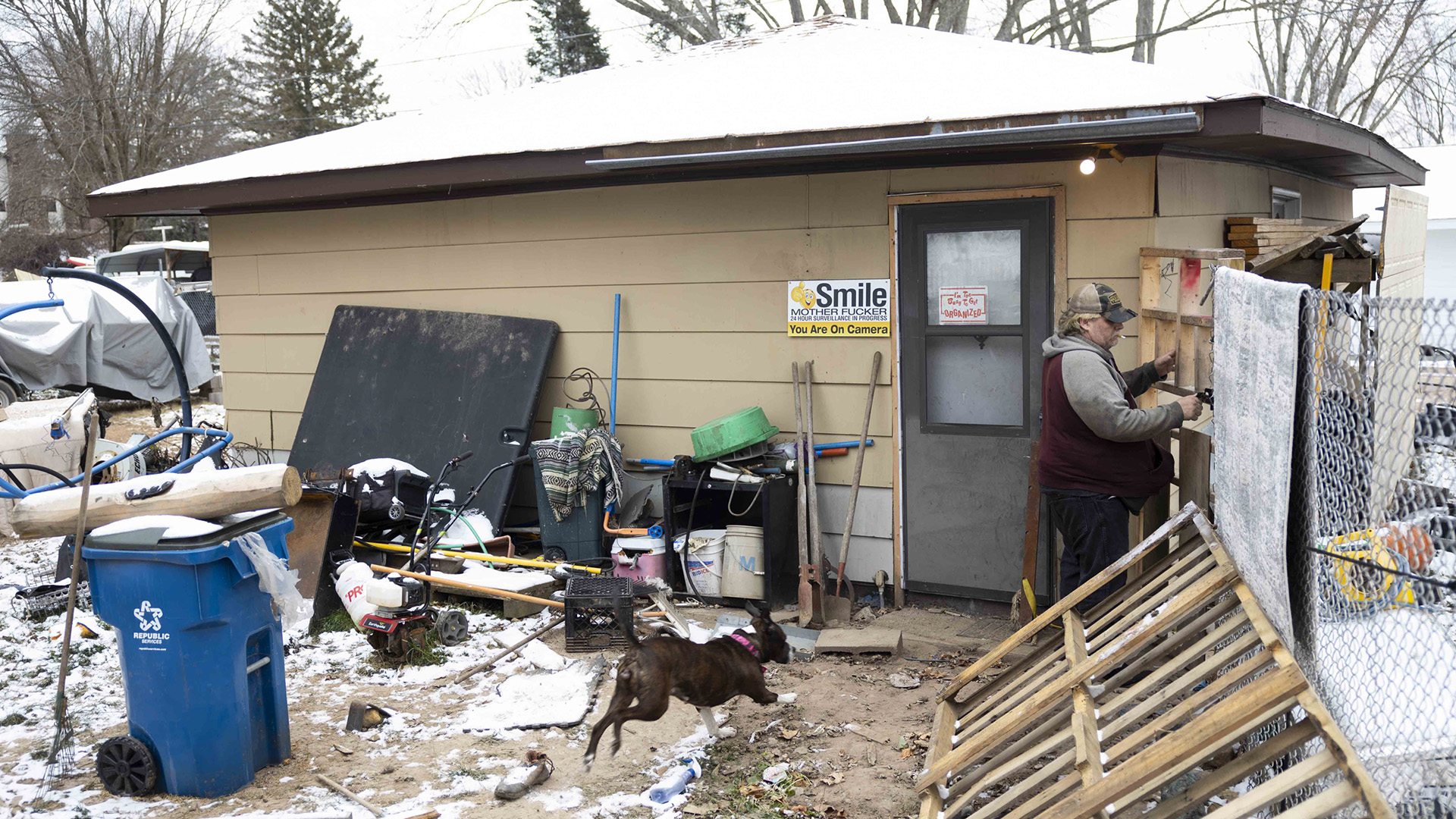
Eric Zieroth unlocks the back gate of the apartment where he’s staying as his dog, Bella, runs after him before driving to his storage unit with his daughter, Christina Hubbell, on Dec. 3, 2024, in Shell Lake. (Credit: Joe Timmerman / Wisconsin Watch)
Among affordability and shortage issues, rural areas are also home to the state’s aging housing stock.
“The housing stock is very old,” Fasula said. “So now you have higher energy bills. And the rent may be lower, but your energy bill is twice as much.”
Her work at the Foundation for Rural Housing provides one-time emergency rental assistance to prevent evictions and homelessness across the state.
“People stereotype them to think ‘Oh, we have these programs because people don’t know how to manage their money.’ It’s not that,” Fasula said. “These are folks that come in that just have a crisis. … They don’t have anything to fall back on. Any little hiccup is a big impact for them financially.”
The foundation is partially funded by the state’s critical assistance grant program, which is awarded to just one eligible agency in Wisconsin. Fasula said the foundation still relies on many private funding sources.
While working to eventually afford an apartment in Shell Lake, Hubbell is making $13.50 an hour at the Dollar General, but only scheduled to work 20 hours a week. The living wage calculation for one adult in Washburn County is $19.45 an hour working 40 hours a week, according to the MIT living wage calculator.
“Homelessness is a housing issue. It’s a symptom of an economy and policies that aren’t working,” Kenion said. “Yes, housing costs tend to be lower in rural communities, but so do wages.”
State funding
In the state’s 2023-25 biennial budget, the Republican-controlled Legislature rejected Democratic Gov. Tony Evers’ recommendations to spend some $24 million on emergency shelter and housing grants, as well as homeless case management services and rental assistance for unhoused veterans.
The Legislature also nixed $250 million Evers proposed for affordable workforce housing and home rehabilitation grants.
The state funds two main grants for homeless shelters and housing annually. The State Shelter Subsidy Grant receives around $1.6 million per year, and the Housing Assistance Program receives $900,000.
But for small shelters like Taylor House — the only homeless shelter in rural Taylor County — Schnabel says the funding is “pennies.” The facility has a continuous waitlist.
“We are a lost people up north, here in the rural areas,” Schnabel said. “I feel like there’s so much focus and so many monetary resources provided to Dane and Milwaukee counties.”
The north central Wisconsin shelter with a 17-person capacity received $10,000 from the State Shelter Subside Grant in 2024, Schnabel said. That’s around $588 per person. But four emergency shelters in Milwaukee with a combined capacity of around 392 received $400,000 from the $1.6 million grant total — $1,020 per person.
“It’s not just local individuals we’re serving,” Schnabel said. “We’re serving individuals from Milwaukee County, Dane County, Fox River Valley, Chippewa. They’re coming from all over because those homeless shelters are either at capacity or their waitlist is too long.”
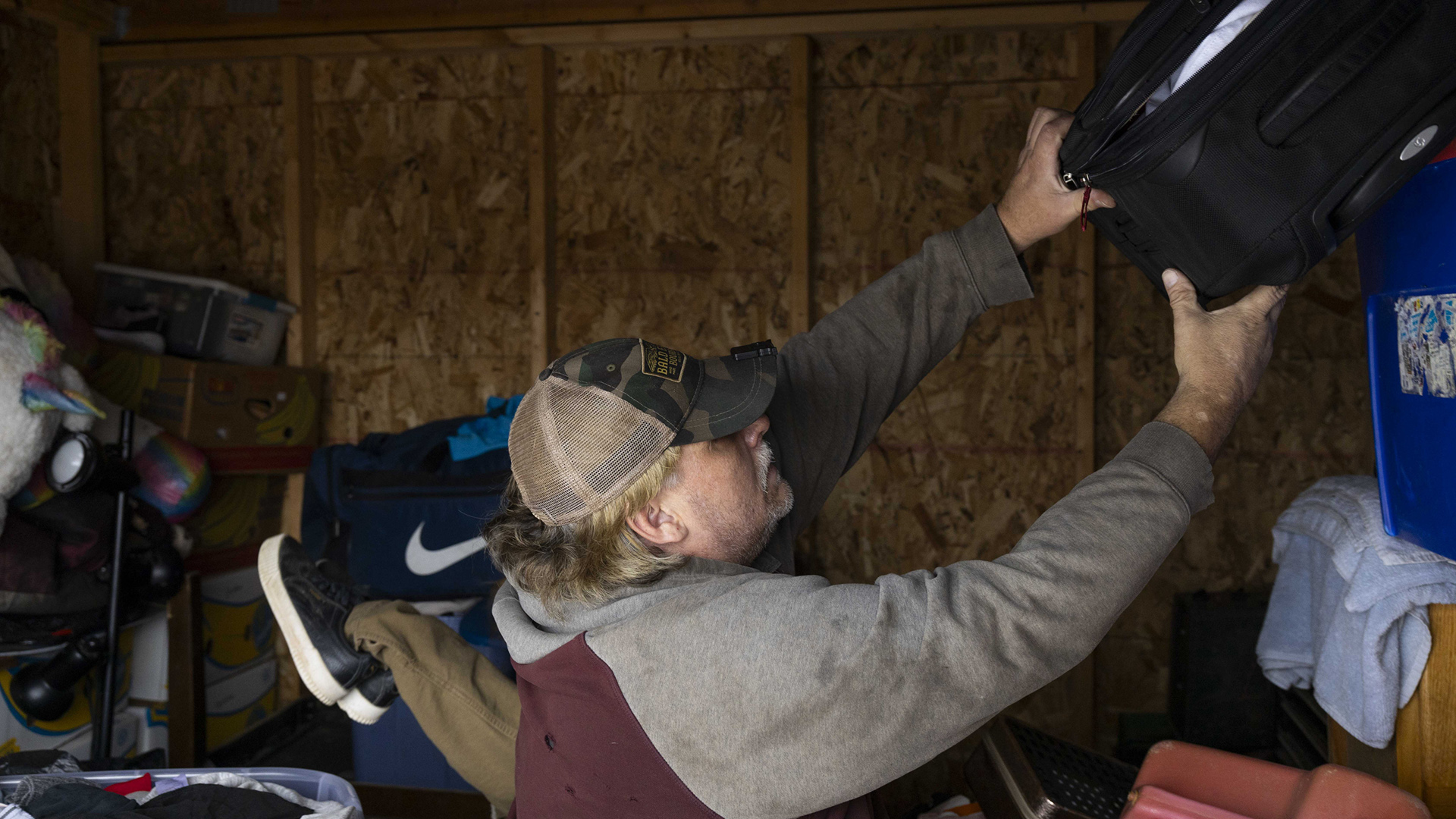
Eric Zieroth pulls a suitcase down from a tall stack of belongings in his storage unit on Dec. 3, 2024, in Shell Lake. (Credit :Joe Timmerman / Wisconsin Watch)
The state’s Recovery Voucher Grant Program awarded $760,000 to grantees in 2024 to provide housing to those experiencing homelessness and struggling with opioid use disorders. Half of these funds went to three providers in Dane, Milwaukee and Waukesha counties.
Another state resource is the Homeless Case Management Services grant program, which distributes up to 10 $50,000 grants per year to shelters and programs that meet eligibility requirements.
Shelter directors like Fitzgerald said the state’s reliance on grant funding to address homelessness and housing needs isn’t sustainable for small providers. While helpful, these pots of money quickly run out, and many of them don’t cover operating costs or wages.
“A lot of these funding sources, it’s like a first come first serve basis, so there isn’t money necessarily allocated to cover our expenses,”” Fitzgerald said. “When the funding runs out, we’re SOL.”
The Lighthouse is the only homeless shelter in Rusk County. Many surrounding shelters are also full, and some counties don’t have shelters at all, leaving people with limited options.
“As fast as we empty out, we fill up. So it’s kind of a revolving door,” Fitzgerald said. “Our first priority is to serve Rusk County residents, but we’re in the business of helping, so I don’t turn people away.”
Small shelters face county-level hurdles
Some shelter workers and advocates say in rural Wisconsin, homelessness is addressed only to the extent that their local governments and administrations are willing to acknowledge the issue and get involved.
“A lot of these people go unnoticed, unchecked in the system, and there just aren’t any county services, especially in our community, that are there to help individuals that are struggling,” Hall said. “We, with a lot of duct tape and a shoestring, hold it down.”
Providers in several rural counties noted that there aren’t any shelters that are owned or operated in any capacity by local governments. In most cases, Washburn County Social Services can only direct homeless residents like Zieroth and Hubbell to the Lakeland Family Resource Center, which provided them with a list of shelters too far out of their reach.
“We don’t have the extra gas or a decent enough vehicle to go too far from Shell Lake,” Zieroth said.

Christina Hubbell counts her quarters to make sure she has enough money for laundry after picking up her winter clothes from a storage unit she shares with her father, Eric Zieroth, on Dec. 3, 2024, in Shell Lake. (Credit: Joe Timmerman / Wisconsin Watch)
The Ashland Community Shelter is the only shelter in a four-county rural area. The city applied for the federal grant funds that allowed Rounsville’s agency to acquire the shelter, but she noted that if it hadn’t taken that step, there wouldn’t be a shelter in Ashland today.
“You still need that county government saying, ‘Hey, we have a program, we need funding,'” Cramer said. “If your county is not looking to deal with homelessness, then they’re probably not asking for that funding either.”
Hall and Schnabel said local governments need to be more involved in their work, whether that be providing a county employee to serve as a shelter director, or simply making better use of the few resources they have.
Schnabel added that small shelters often cannot pay their directors a decent wage, resulting in frequent staff turnover. Taylor House has had four directors in the last 18 months, he said. The inconsistency leaves “a bad taste” in the mouth of those reviewing their grant applications.
According to Hall, some counties are much more willing than others to utilize Comprehensive Community Services — a state program aimed at addressing substance abuse and mental health needs. The program allows counties to contract employees and case managers at local shelters who provide services such as skills development and peer support. If the notes are done properly, the county can bill those expenses back to the state through BadgerCare.
But despite those being reimbursable expenses, some county officials either don’t know how or are unwilling to engage in the program, Hall said.
“The tool is there, it just needs to be utilized,” he said. “Because of their unwillingness to try something, it oftentimes ends up having to tell people ‘no,’ and we’re moving them to another county.”
He added that allowing local shelters that serve those covered under BadgerCare to bill the state directly for these services instead of relying on the county to initiate it “would solve the problem tomorrow.”
Hall also noted that county governments can use their opioid settlement funds to provide housing and shelter to those with eligible needs, yet some have instead spent it on other things.
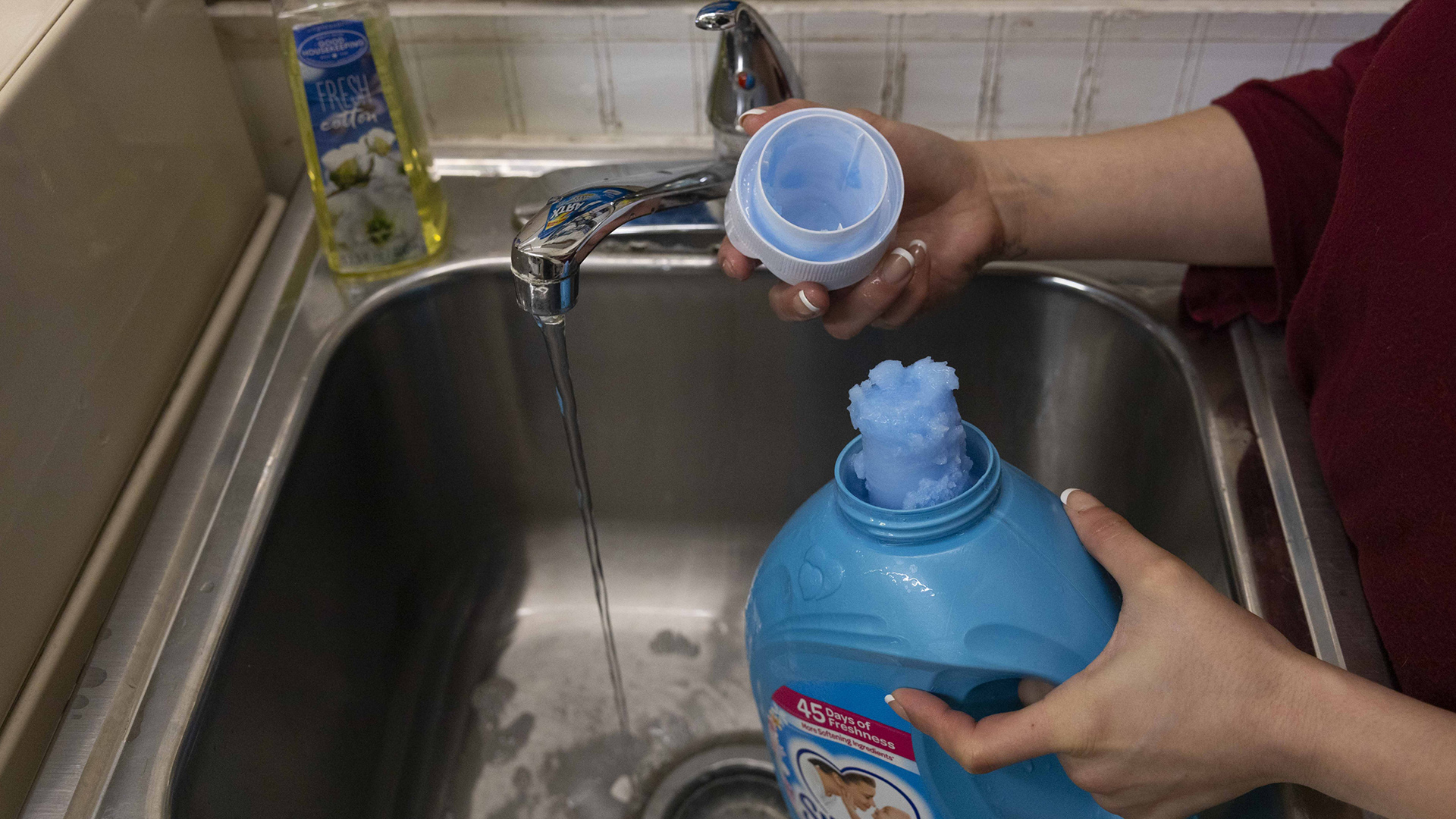
Christina Hubbell runs hot water at a laundromat to melt her frozen laundry detergent after picking up her winter clothes from a storage unit she shares with her father, Eric Zieroth, on Dec. 3, 2024, in Shell Lake. (Credit: Joe Timmerman / Wisconsin Watch)
Waupaca County, for example, told Wisconsin Watch it has spent nearly $100,000 in opioid settlement funds on awareness campaigns, training, a counselor position and equipment that helps local police quickly identify narcotics in the field.
Grant funding is often allocated to regional “parent” organizations, like a Salvation Army, which then distribute the money to local nonprofits and shelters. But Schnabel said the state must force the hand of counties that “choose not to see homelessness.”
“By requiring that these funds go through the county to be disbursed to the homeless shelter, it forces the county to have a relationship and have skin in the game with the shelters,” he said.
Another challenge is that some small communities like Ashland reject homeless shelters, assuming they will bring negative footprints.
“There’s going to be needles, the neighborhood houses are going to be robbed, children are going to be ran over on the highway,” Rounsville said. “There’s all kinds of things that came up when we were doing the change of use for this hotel to become a shelter. It was something that not everybody wanted to see in the community.”
The small city of Clintonville approved an ordinance last winter enforcing a 60-day limit on local hotel stays in a six-month period, citing drug concerns, disorderly conduct and disturbances. Many homeless individuals in the area are put up in those hotels.
“We’re trying to figure out, what are we going to do with those 50 people this winter when the police departments come through and say they have to get out,” Hall said.

Eric Zieroth shows his scarred hand where he suffered a workplace injury that continues to keep him from working, Dec. 4, 2024, in Shell Lake. (Credit: Joe Timmerman / Wisconsin Watch)
Studies estimate that every year, someone experiencing chronic homelessness costs a community $30,000 to $50,000, according to the Interagency Council on Homelessness. Yet for each person who is homeless, permanent supportive housing costs communities $20,000 per year.
“These are our neighbors in any community, and when they are no longer homeless and they are thriving, they reinvest that into the economy, into the community, into the neighborhood,” Kenion said.
While often doing more with less, local nonprofits are still the ones that are built to do this work, Hall said.
“There is no solution. There is no algorithm to get us to an answer,” Schnabel said. “But what we know is that there needs to be a place that they can go to be safe, and have warm, secure housing until they can get back on their feet.”
Shunned by their community
In June, Zieroth and Hubbell pulled their car into a Shell Lake gas station parking lot to sleep, shortly before a police officer was called and arrived to tell them they were trespassing and had to leave.
In August, the father and daughter stopped at the Shell Lake ATV Campground to use the public showers, when a campground employee entered and demanded that Zieroth get his daughter and leave. The employee called Shell Lake police, who escorted him off the property.
A resident living next to the boat launch where they stayed eventually took issue with them parking their car at the public lot. In October, Hubbell said the homeowner stormed into the Dollar General while she was working and told her they couldn’t sleep there anymore, threatening to call the police.
And one night after finding a group fishing at the boat launch, the pair decided to drive to another public landing in Burnett County where they parked and slept. Still under their blankets, they woke the next morning to a DNR officer and county sheriff’s deputy approaching, asking about Zieroth’s “drug of choice.” According to Wisconsin Court System records, Zieroth served time in prison for burglary as a 21-year-old, but has never faced drug-related charges.
They were told to leave.
“They just did not want us in this area. We’re less than a mile from where we grew up, and from where she went to school and graduated,” Zieroth said, pointing to his daughter. “I’ve made my life here … everything points to ‘get out.'”
While still homeless, the pair were fortunate enough to find a temporary place to stay as the weather gets colder — a small room in the unfinished basement of an acquaintance who didn’t want to see them living out of their car. They are joined by their dog Bella, who Zieroth won’t abandon after she woke him the night his camper caught fire in 2022, allowing him to escape and likely saving his life.
Zieroth and Hubbell have an old bed, a recliner and a bathroom for now. But their most cherished comfort is that the room is heated — something they don’t take for granted after a winter spent in their car.
With a roof over their heads, Zieroth hopes to finally get the surgery he needs, but he’s unsure of how long they can stay.
They insist on paying the homeowners $50 a week — all they can afford — for letting them stay in the basement. Zieroth uses his skills as a mechanic to fix things around the property, and Hubbell picks items up for them at the Dollar General whenever she can.
Once healed, he wants to get back to work and acquire a property of his own, but his first priority is his daughter. After getting on her feet, Hubbell hopes to go to cosmetology school in Rice Lake.
“She has her whole life ahead of her and experience has taught me that some real bad beginnings get really good endings, and she deserves a good one,” Zieroth said.
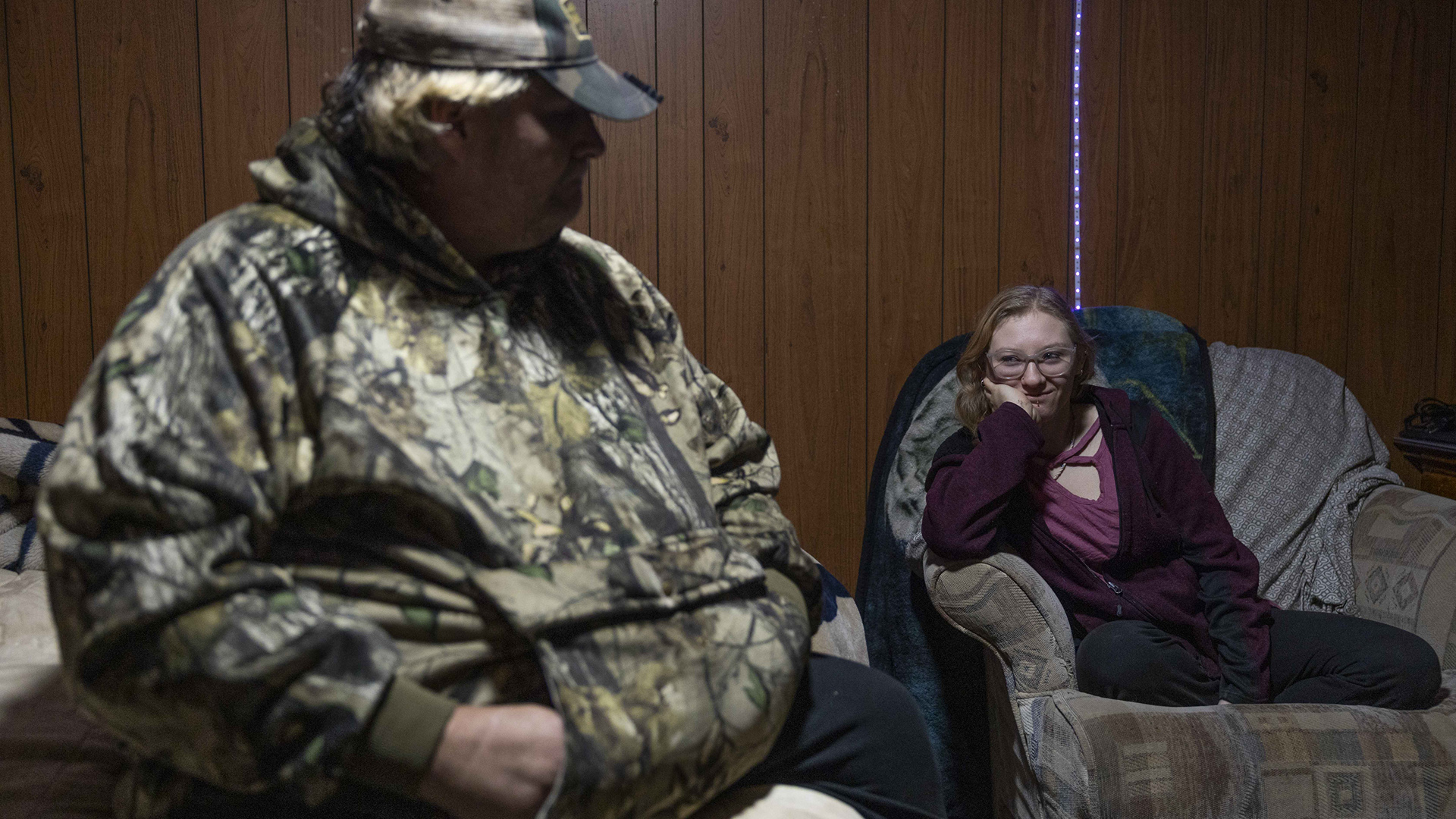
Eric Zieroth, left, and Christina Hubbell pose for a portrait in their room on Dec. 4, 2024, in Shell Lake. Zieroth and Hubbell had recently moved into a friend’s basement apartment after living in their car for over a year. (Credit: Joe Timmerman / Wisconsin Watch)
How to find help
If you or someone you know is experiencing or is at risk of experiencing homelessness, please consider the following resources:
- One-time emergency assistance: Wisconsin Foundation for Rural Housing
- Identify the agency that serves your county: Wisconsin Community Action Network
- Identify your county to locate services: Wisconsin Balance of State Continuum of Care
- Recovery residence and services provided in Waupaca, Waushara, Outagamie, Portage, Winnebago and Shawano counties: Impact Wisconsin
 Passport
Passport




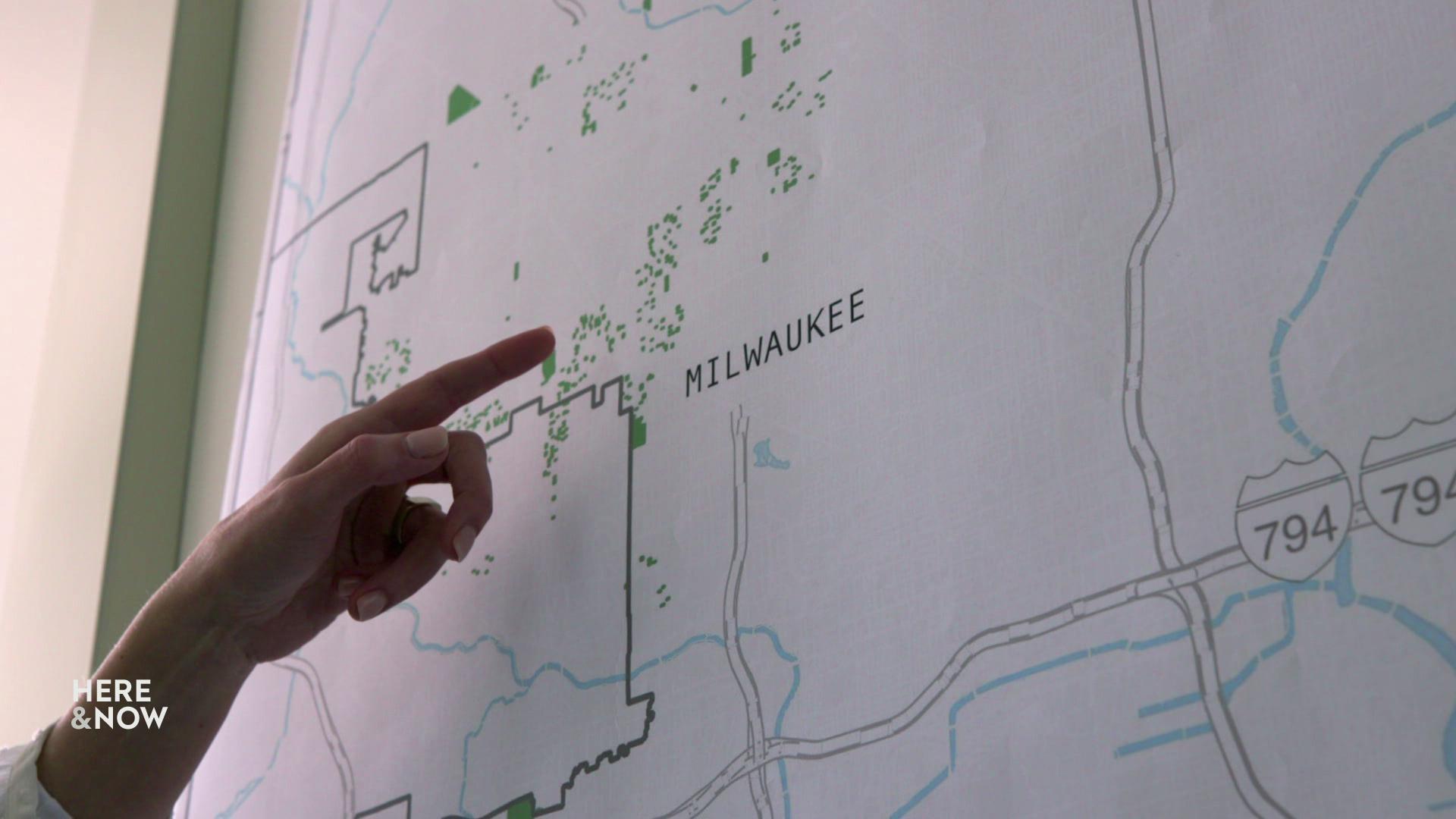


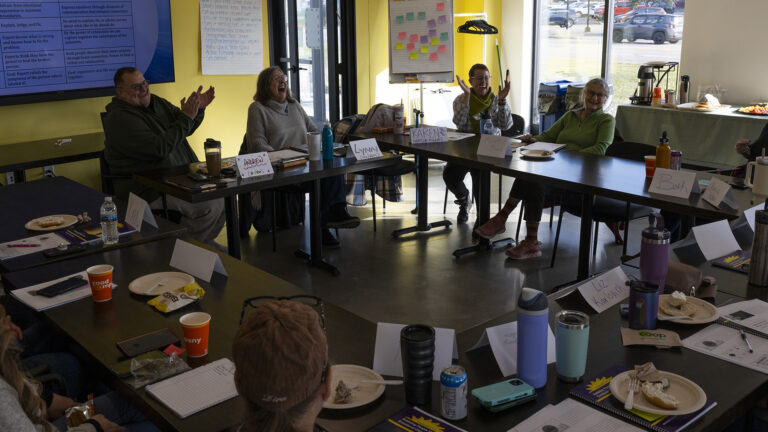
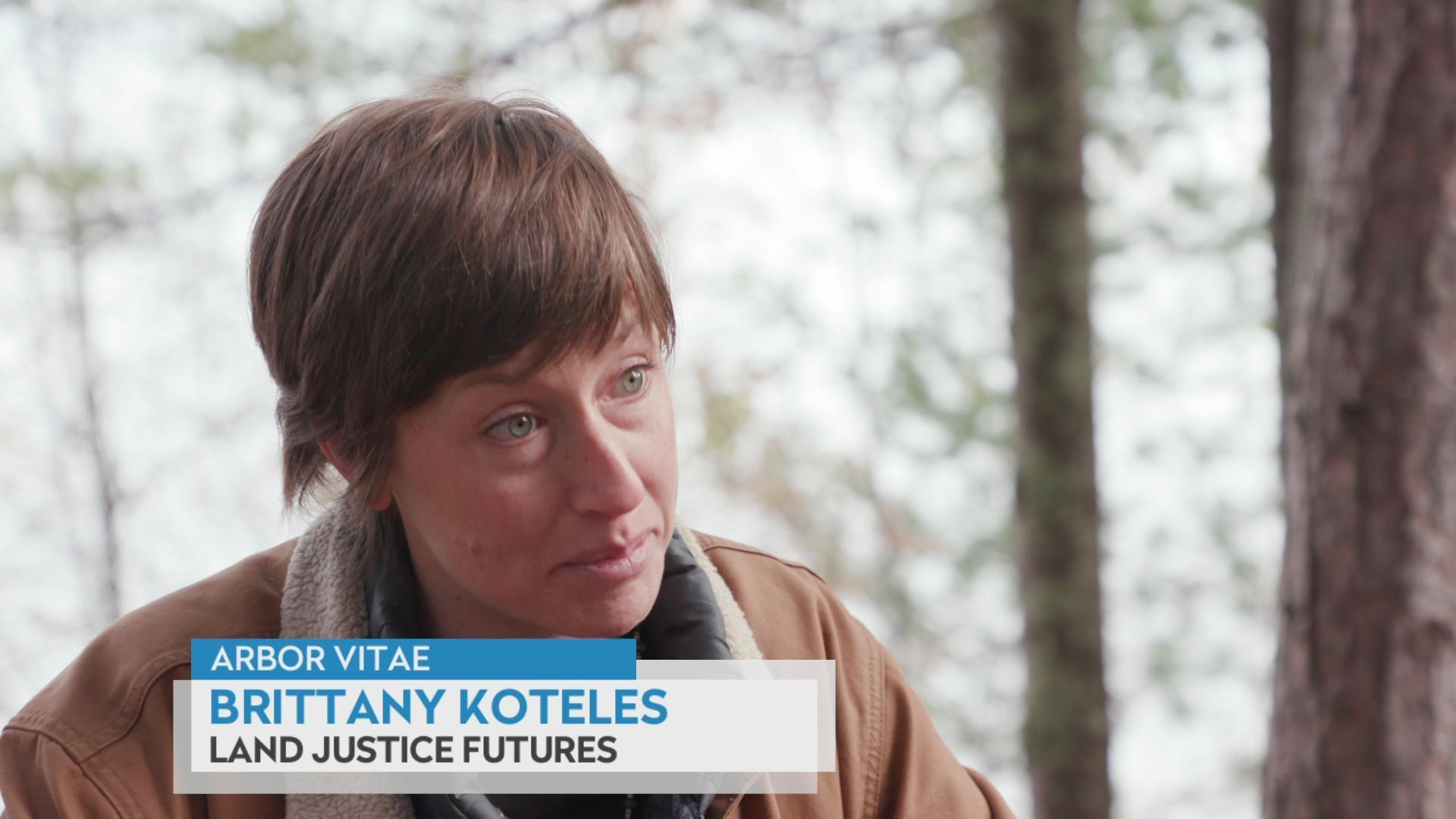
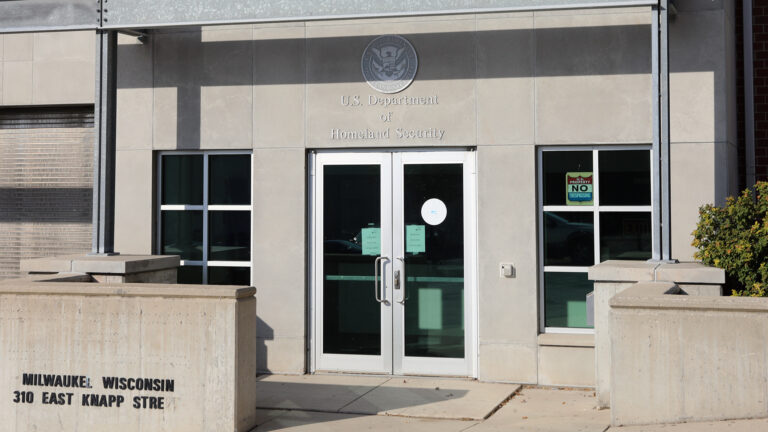

Follow Us